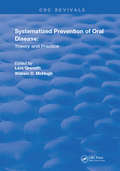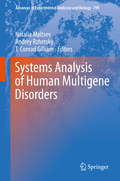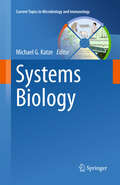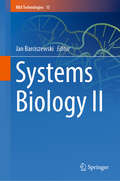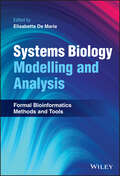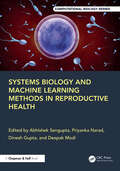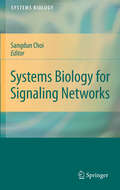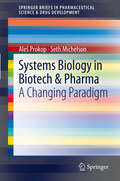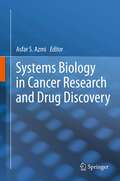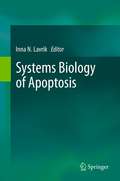- Table View
- List View
Systemisch-konstruktivistisches Didaktisches Reasoning: Lernen im Behandlungsprozess mit Beispielen aus der Sprachtherapie (essentials)
by Andreas WolfsLernen ist ein zentraler Aspekt von Behandlungen in der Medizin, Pflege und Therapie. Der systemisch-konstruktivistische Blick auf die Gestaltung von Lehr-/Lernsituationen im Rahmen des didaktischen Reasonings ermöglicht relevante Erkenntnisse für die patienten- und teilhabeorientierte Gestaltung. Dieses essential stellt die Unterschiedlichkeit der Lehr-/Lernaktivitäten in sechs Handlungsebenen von drei Behandlungsphasen dar. Dabei bietet es eine Differenzierung zwischen bewusstem und unbewusstem didaktischen Reasoning sowie zwischen Tele- und Präsenzsetting. Zwei sprachtherapeutische Beispiele unterstützen den Übertrag in den eigenen beruflichen Alltag.
Systemisch-konstruktivistisches Interaktives Reasoning: Kommunikation und Beratung im Behandlungsprozess an Beispielen der Logopädie (essentials)
by Andreas WolfsIndividuelle und personenzentrierte Kommunikation ist essentieller Bestandteil jeder Behandlung in Medizin, Pflege und Therapie. In diesem essential werden die Aspekte des interaktiven Reasonings systemisch-konstruktivistisch ausgedeutet und im Kontext von sechs Handlungsebenen in drei Behandlungsphasen betrachtet. Begriffe wie Kontingenz, Anschlussfähigkeit und Perturbationstoleranz bieten dabei Möglichkeiten, eine teilhabeorientierte Kommunikation zu differenzieren. Zur Veranschaulichung der einzelnen Betrachtungsebenen unterstützen zwei sprachtherapeutische Beispiele und Ausführungen zum bewussten interaktiven Reasoning als Grundlage der Reflexion. Besonderes Augenmerk wird auf die behandlungsinduzierte Beratung als spezielle und relevante Form der Kommunikation gelegt.
Systemische Supervision im Rettungsdienst: Methoden, Instrumente und Fallbeispiele für die Umsetzung
by Gordon Heringshausen Natalie-Reyes Castellanos-Herr Ivo WintersteinSystemische Supervision im Rettungsdienst – Stärke, Reflexion, Teamgeist Einsatzkräfte stehen täglich vor enormen Herausforderungen. Mentale Stärke, Teamzusammenhalt und professionelle Weiterentwicklung sind dabei essenziell. Systemische Supervision bietet wertvolle Unterstützung: Sie hilft, individuelle und gemeinsame Ressourcen zu erkennen, stärkt die Selbstreflexion und verbessert die Kommunikation im Team. Dieses Buch bietet praxisnahe Impulse für einen wertschätzenden und lösungsorientierten Umgang im Berufsalltag. Es zeigt, wie systemische Supervision dazu beitragen kann, mit rettungsdienstlichen Anforderungen gut umzugehen und langfristig zu einem gesunden, effektiven Arbeitsumfeld beizutragen. Ein wertvolles Werkzeug für alle, die ihre professionelle Entwicklung aktiv gestalten und ihre Teams nachhaltig stärken möchten.
Systemische Supervision in der Pflege: Methoden, Instrumente und Fallbeispiele für die Umsetzung
by Gordon Heringshausen Natalie-Reyes Castellanos-Herr Ivo WintersteinSystemische Supervision in der Pflege – Unterstützung, Reflexion, Entlastung Pflegekräfte meistern täglich herausfordernde und emotional belastende Situationen. Systemische Supervision bietet wertvolle Hilfe: Sie stärkt die Selbstreflexion, verbessert die Teamkommunikation und hilft, Konflikte konstruktiv zu bewältigen. Dieses Buch zeigt praxisnah, wie Supervision gezielt eingesetzt werden kann, um Pflegekräfte zu entlasten und die Qualität der Pflege nachhaltig zu steigern. Mit konkreten Beispielen und erprobten Methoden wird deutlich, wie Einzelne und Teams gleichermaßen profitieren können. Ein unverzichtbarer Begleiter für alle, die ihre professionelle Pflegearbeit mit mehr Klarheit und Unterstützung gestalten möchten.
Systemized Prevention of Oral Disease: Theory and Practice (Routledge Revivals)
by Lars Granath William D. McHughFirst published in 1986: This book presents a new approach to oral diseases. Recent decades have seen the proliferation of methods to prevent these diseases and enormous growth in the underlying scientific knowledge and mechanisms of prevention.
Systems Analysis Tools for Better Health Care Delivery
by Panos M. Pardalos Petraq Papajorgji Pando G. Georgiev Britta NeugaardThis book presents some recent systems engineering and mathematical tools for health care along with their real-world applications by health care practitioners and engineers. Advanced approaches, tools, and algorithms used in operating room scheduling and patient flow are covered. State-of-the-art results from applications of data mining, business process modeling, and simulation in healthcare, together with optimization methods, form the core of the volume. Systems Analysis Tools for Better Health Care Delivery illustrates the increased need of partnership between engineers and health care professionals. This book will benefit researchers and practitioners in health care delivery institutions, staff members and professionals of specialized hospital units, and lecturers and graduate students in engineering, applied mathematics, business administration and health care.
Systems Analysis of Chromatin-Related Protein Complexes in Cancer
by Andrew Emili Shoshana Wodak Jack GreenblattEpigenetic modifications underlie all aspects of human physiology, including stem cell renewal, formation of cell types and tissues. They also underlie environmental impacts on human health, including aging and diseases like cancer. Consequently, cracking the epigenetic "code" is considered a key challenge in biomedical research. Chromatin structure and function are modified by protein complexes, causing genes to be turned "on" or "off" and controlling other aspects of DNA function. Yet while there has been explosive growth in the epigenetics field, human chromatin-modifying machines have only recently started to be characterized. To meet this challenge, our book explores complementary experimental tracks, pursued by expert international research groups, aimed at the physical and functional characterization of the diverse repertoire of chromatin protein machines - namely, the "readers, writers and erasers" of epigenomic marks. These studies include the identification of RNA molecules and drugs that interact selectively with components of the chromatin machinery. What makes this book distinctive is its emphasis on the systematic exploration of chromatin protein complexes in the context of human development and disease networks.
Systems Analysis of Human Multigene Disorders
by Natalia Maltsev Andrey Rzhetsky T. Conrad GilliamUnderstanding the genetic architecture underlying complex multigene disorders is one of the major goals of human genetics in the upcoming decades. Advances in whole genome sequencing and the success of high throughput functional genomics allow supplementing conventional reductionist biology with systems-level approaches to human heredity and health as systems of interacting genetic, epigenetic, and environmental factors. This integrative approach holds the promise of unveiling yet unexplored levels of molecular organization and biological complexity. It may also hold the key to deciphering the multigene patterns of disease inheritance.
Systems Biology
by Jens Nielsen Gregory Stephanopoulos Sang Yup Lee J. Nielsen Stefan HohmannComprehensive coverage of the many different aspects of systems biology, resulting in an excellent overview of the experimental and computational approaches currently in use to study biological systems. Each chapter represents a valuable introduction to one specific branch of systems biology, while also including the current state of the art and pointers to future directions. Following different methods for the integrative analysis of omics data, the book goes on to describe techniques that allow for the direct quantification of carbon fluxes in large metabolic networks, including the use of 13C labelled substrates and genome-scale metabolic models. The latter is explained on the basis of the model organism Escherichia coli as well as the human metabolism. Subsequently, the authors deal with the application of such techniques to human health and cell factory engineering, with a focus on recent progress in building genome-scale models and regulatory networks. They highlight the importance of such information for specific biological processes, including the ageing of cells, the immune system and organogenesis. The book concludes with a summary of recent advances in genome editing, which have allowed for precise genetic modifications, even with the dynamic control of gene expression. This is part of the Advances Biotechnology series, covering all pertinent aspects of the field with each volume prepared by eminent scientists who are experts on the topic in question.
Systems Biology
by Michael G. KatzeFirst, systems biology is an inter-disciplinary approach, requiring the combined talents of biologists, mathematicians, and computer scientists. Second, systems biology is holistic, with the goal of obtaining a comprehensive understanding of the workings of biological systems. This is achieved through the acquisition of massive amounts of data by high-throughput technologies--oligonucleotide microarrays, mass spectrometry, and next-generation sequencing--and the analysis of this data through sophisticated mathematical algorithms. It is perhaps the use of mathematics, to integrate abundant and diverse types of data and to generate models of interconnected molecular networks, that best characterizes systems biology.
Systems Biology (Rna Technologies Ser.)
by Jan Barciszewski Stefan Jurga Nikolaus RajewskyMany breakthroughs in experimental devices, advanced software, as well as analytical methods for systems biology development have helped shape the way we study DNA, RNA and proteins, on the genomic, transcriptional, translational and posttranslational level. This book highlights the comprehensive topics that encompass systems biology with enormous progress in the development of genome sequencing, proteomic and metabolomic methods in designing and understanding biological systems.Topics covered in this book include fundamentals of modelling networks, circuits and pathways, spatial and multi cellular systems, image-driven systems biology, evolution, noise and decision-making in single cells, systems biology of disease and immunology, and personalized medicine. Special attention is paid to epigenomics, in particular environmental conditions that impact genetic background. The breadth of exciting new data towards discovering fundamental principles and direct application of epigenetics in agriculture is also described.The chapter “Deciphering the Universe of RNA Structures and Trans RNA-RNA Interactions of Transcriptomes in vivo - from Experimental Protocols to Computational Analyses” is available open access under a CC BY 4.0 license via link.springer.com.
Systems Biology Approaches: Prevention, Diagnosis, and Understanding Mechanisms of Complex Diseases
by Sanket Joshi Rina Rani Ray Moupriya Nag Dibyajit LahiriThis book examines the development and applications of system biology approaches for the prevention, diagnosis, and understanding of disease mechanisms. It explores the applications of system biology in infectious diseases, including host-pathogen interaction, and the identification of targets for new therapeutics and intervention strategies. It covers the use of system biology for understanding and treating metabolic disorders towards personalized and precision medicine. The book further discusses the systems biology approaches for understanding the mechanisms of tumor progression and designing more effective cancer therapies. The chapter also reviews the current strategies in autoimmune disease treatment and highlights the opportunity that systems biology represents for the development of better and safer treatments. Importantly, the book discusses the current state of the systems-level understanding of diseases and both the therapeutic and adverse mechanisms of drug actions usingsystem biology approaches. Cutting across the disciplines, this book is a valuable source for researchers in genetics, molecular biology, cell biology, microbiology, and biomedical sciences.
Systems Biology II (RNA Technologies #15)
by Jan BarciszewskiModern biology is moving away from reductionist approaches towards holistic studies that encompass whole genomes, transcriptomes, proteomes, and metabolomes. Systems biology is an approach to studying complex biological systems by looking at many biomolecules in a comprehensive way. The aim is to gain a thorough understanding of the biological functions of different classes of molecules and their interactions. Systems Biology II is an up-to-date and comprehensive guide to the latest developments in systems biology, with a particular focus on RNA-based technologies. This book is the second volume in the RNA Technologies series dedicated to this topic. It presents cutting-edge approaches and tools for modelling and analyzing complex biological systems at different levels, from molecular interactions to cellular networks and beyond. With contributions from leading experts in the field, the book covers a wide range of topics, including gene regulatory networks, epigenetics, synthetic biology, omics data analysis, network inference, and more. It explores applications in various areas of the life sciences and biomedicine, such as vaccine development, cancer research, transplantation research and pathogenic processes. This volume is an essential resource for scientists and students working in systems biology, bioinformatics, synthetic biology, and related fields, as well as anyone interested in the latest advances in RNA technologies and their applications in biology and medicine.
Systems Biology Modelling and Analysis: Formal Bioinformatics Methods and Tools
by Elisabetta De MariaSystems Biology Modelling and Analysis Describes important modelling and computational methods for systems biology research to enable practitioners to select and use the most suitable technique Systems Biology Modelling and Analysis provides an overview of state-of-the-art techniques and introduces related tools and practices to formalize models and automate reasoning for systems biology. The authors present and compare the main formal methods used in systems biology for modelling biological networks, including discussion of their advantages, drawbacks, and main applications. Each chapter includes an intuitive presentation of the specific formalism, a brief history of the formalism and of its applications in systems biology, a formal description of the formalism and its variants, at least one realistic case study, some applications of formal techniques to validate and make deep analysis of models encoded with the formalism, and a discussion on the kind of biological systems for which the formalism is suited, along with concrete ideas on its possible evolution. Edited by a highly qualified expert with significant experience in the field, some of the methods and techniques covered in Systems Biology Modelling and Analysis include: Petri nets, an important tool for studying different aspects of biological systems, ranging from simple signaling pathways to metabolic networks and beyond Pathway Logic, a formal, rule-based system and interactive viewer for developing executable models of cellular processes Boolean networks, a mathematical model which has been widely used for decades in the context of biological regulation networks Answer Set Programming (ASP), which has proven to be a strong logic programming paradigm to deal with the inherent complexity of biological models For systems biologists, biochemists, bioinformaticians, molecular biologists, pharmacologists, and computer scientists, Systems Biology Modelling and Analysis is a comprehensive all-in-one resource to understand and harness the field’s current models and techniques while also preparing for their potential developments in coming years with the help of the author’s expert insight.
Systems Biology Volume 1: Integrative Biology and Simulation Tools
by Aleš Prokop Bela CsukasGrowth in the pharmaceutical market has slowed down - almost to a standstill. One reason is that governments and other payers are cutting costs in a faltering world economy. But a more fundamental problem is the failure of major companies to discover, develop and market new drugs. Major drugs losing patent protection or being withdrawn from the market are simply not being replaced by new therapies - the pharmaceutical market model is no longer functioning effectively and most pharmaceutical companies are failing to produce the innovation needed for success. This multi-authored new book looks at a vital strategy which can bring innovation to a market in need of new ideas and new products: Systems Biology (SB). Modeling is a significant task of systems biology. SB aims to develop and use efficient algorithms, data structures, visualization and communication tools to orchestrate the integration of large quantities of biological data with the goal of computer modeling. It involves the use of computer simulations of biological systems, such as the networks of metabolites comprise signal transduction pathways and gene regulatory networks to both analyze and visualize the complex connections of these cellular processes. SB involves a series of operational protocols used for performing research, namely a cycle composed of theoretical, analytic or computational modeling to propose specific testable hypotheses about a biological system, experimental validation, and then using the newly acquired quantitative description of cells or cell processes to refine the computational model or theory.
Systems Biology and Bioinformatics: A Computational Approach
by Kayvan Najarian Siamak Najarian Shahriar Gharibzadeh Christopher N. EichelbergerThe availability of molecular imaging and measurement systems enables today's biologists to swiftly monitor thousands of genes involved in a host of diseases, a critical factor in specialized drug development. Systems Biology and Bioinformatics: A Computational Approach provides students with a comprehensive collection of the computational methods
Systems Biology and Machine Learning Methods in Reproductive Health (Chapman & Hall/CRC Computational Biology Series)
by Dinesh Gupta Abhishek Sengupta Priyanka Narad Deepak ModiSystems Biology and Machine Learning Methods in Reproductive Health is an innovative and wide-ranging book that discovers the synergetic combination of disciplines: systems biology and machine learning, with an application in the field of reproductive health. This book assembles the expertise of leading scientists and clinicians to present a compilation of cutting-edge techniques and case studies utilizing computational methods to elucidate intricate biological systems, elucidate reproductive pathways, and address critical issues in the fields of fertility, pregnancy, and reproductive disorders. Bringing science and data science together, this groundbreaking book provides scientists, clinicians, and students with a step-by-step guide to uncovering the complexities of reproductive health through cutting-edge computational tools.
Systems Biology for Signaling Networks
by Sangdun ChoiSystem Biology encompasses the knowledge from diverse fields such as Molecular Biology, Immunology, Genetics, Computational Biology, Mathematical Biology, etc. not only to address key questions that are not answerable by individual fields alone, but also to help in our understanding of the complexities of biological systems. Whole genome expression studies have provided us the means of studying the expression of thousands of genes under a particular condition and this technique had been widely used to find out the role of key macromolecules that are involved in biological signaling pathways. However, making sense of the underlying complexity is only possible if we interconnect various signaling pathways into human and computer readable network maps. These maps can then be used to classify and study individual components involved in a particular phenomenon. Apart from transcriptomics, several individual gene studies have resulted in adding to our knowledge of key components that are involved in a signaling pathway. It therefore becomes imperative to take into account of these studies also, while constructing our network maps to highlight the interconnectedness of the entire signaling pathways and the role of that particular individual protein in the pathway. This collection of articles will contain a collection of pioneering work done by scientists working in regulatory signaling networks and the use of large scale gene expression and omics data. The distinctive features of this book would be: Act a single source of information to understand the various components of different signaling network (roadmap of biochemical pathways, the nature of a molecule of interest in a particular pathway, etc.), Serve as a platform to highlight the key findings in this highly volatile and evolving field, and Provide answers to various techniques both related to microarray and cell signaling to the readers.
Systems Biology in Biotech & Pharma
by Seth Michelson Aleš ProkopThe US is currently well ahead of the rest of the world in the development and application of SB and its principles especially as they pertain to basic medical research and development. This lead is largely due to its earlier start in the academic arena. However, there is evidence of rapid development in both the UK/EU and Japan, and the gap is narrowing, particularly in the UK. From an industrial point of view, the Pharmaceutical Industry based in the US and UK can capitalize on these opportunities and gain the benefits of this technology. Many educational institutions (particularly their medical divisions) at present are heavily business-oriented, realize that in this particular industrial environment, that every dollar counts.
Systems Biology in Cancer Research and Drug Discovery
by Asfar S AzmiSystems Biology in Cancer Research and Drug Discovery provides a unique collection of chapters, by world-class researchers, describing the use of integrated systems biology and network modeling in the cancer field where traditional tools have failed to deliver expected promise. This book touches four applications/aspects of systems biology (i) in understanding aberrant signaling in cancer (ii) in identifying biomarkers and prognostic markers especially focused on angiogenesis pathways (iii) in unwinding microRNAs complexity and (iv) in anticancer drug discovery and in clinical trial design. This book reviews the state-of-the-art knowledge and touches upon cutting edge newer and improved applications especially in the area of network modeling. It is aimed at an audience ranging from students, academics, basic researcher and clinicians in cancer research. This book is expected to benefit the field of translational cancer medicine by bridging the gap between basic researchers, computational biologists and clinicians who have one ultimate goal and that is to defeat cancer.
Systems Biology in Drug Discovery and Development
by Daniel L. Young Seth MichelsonThe first book to focus on comprehensive systems biology as applied to drug discovery and development Drawing on real-life examples, Systems Biology in Drug Discovery and Development presents practical applications of systems biology to the multiple phases of drug discovery and development. This book explains how the integration of knowledge from multiple sources, and the models that best represent that integration, inform the drug research processes that are most relevant to the pharmaceutical and biotechnology industries. The first book to focus on comprehensive systems biology and its applications in drug discovery and development, it offers comprehensive and multidisciplinary coverage of all phases of discovery and design, including target identification and validation, lead identification and optimization, and clinical trial design and execution, as well as the complementary systems approaches that make these processes more efficient. It also provides models for applying systems biology to pharmacokinetics, pharmacodynamics, and candidate biomarker identification. Introducing and explaining key methods and technical approaches to the use of comprehensive systems biology on drug development, the book addresses the challenges currently facing the pharmaceutical industry. As a result, it is essential reading for pharmaceutical and biotech scientists, pharmacologists, computational modelers, bioinformaticians, and graduate students in systems biology, pharmaceutical science, and other related fields.
Systems Biology in Drug Discovery and Development: Methods and Protocols
by Qing YanDue to the failing "one-drug-fits-all" model, it has become increasingly necessary to develop personalized medicine that treats whole systems and brings the right drug to the right patient with the right dosages. In Systems Biology in Drug Discovery and Development: Methods and Protocols, leading experts provide a practical, state-of-the-art, and holistic view of the translation of systems biology into better drug discovery and personalized medical practice. While the first part of the book describes cutting-edge technologies and methods in the field, the second part illustrates how the technologies can be applied in science for disease understanding and therapeutic discovery. As a volume in the highly successful Methods in Molecular BiologyTM series, this collection provides the kind of detailed description and implementation advice that is crucial for getting optimal results. Authoritative and up-to-date, Systems Biology in Drug Discovery and Development: Methods and Protocols covers topics from fundamental concepts to advanced technologies in order to best serve biomedical students and professionals at all levels who are interested in vital integrative studies in molecular biology, genetics, bioinformatics, bioengineering, biochemistry, physiology, pathology, microbiology, immunology, pharmacology, toxicology, drug discovery, and clinical medicine.
Systems Biology of Alzheimer's Disease
by Juan I. Castrillo Stephen G. OliverAlzheimer's disease (AD) and many other neurodegenerative disorders are multifactorial in nature, involving a combination of genomic, epigenomic, network dynamic and environmental factors. A proper investigation requires new integrative Systems Biology approaches, at both the experimental and computational level. The interplay of disease mechanisms and homeostatic networks will underlie the time of onset and rate of progression of the disease. This book addresses such an integrated approach to AD. It aims to present Systems Biology, including both experimental and computational approaches, as a new strategy for the study of AD and other multifactorial diseases, with the hope that the results will translate into more effective diagnosis and treatment, as well as improved public health policies. Written for the highly successful Methods in Molecular Biology series, practical and cutting-edge, Systems Biology of Alzheimer's Disease is intended for post-graduate students, post-doctoral researchers and experts in different fields with an interest in comprehensive Systems Biology strategies applicable to AD and other complex multifactorial diseases (including other neurodegenerative diseases and cancers). This book aims to complement other excellent volumes and monographs on AD that cover fundamental, physiological or medical aspects of the disease.
Systems Biology of Apoptosis
by Inna N. LavrikSystems Biology of Apoptosis summarizes all current achievements in this emerging field. Apoptosis is a process common to all multicellular organisms. Apoptosis leads to the elimination of cells via a complex but highly defined cellular programme. Defects in the regulation of apoptosis result in serious diseases such as cancer, autoimmunity, AIDS and neurodegeneration. Recently, a substantial step forward in understanding the complex apoptotic pathways has been made by utilising systems biology approaches. Systems biology combines rigorous mathematical modelling with experimental approaches in a closed loop cycle for advancing our knowledge about complex biological processes. In this book, the editor describes the contemporary systems biology studies devoted to apoptotic signaling and focuses on the question how systems biology helps to understand life/death decisions made in the cell and to develop new approaches to rational treatment strategies.
Systems Biology of Cancer
by Sam ThiagalingamWith over 200 types of cancer diagnosed to date, researchers the world over have been forced to rapidly update their understanding of the biology of cancer. In fact, only the study of the basic cellular processes, and how these are altered in cancer cells, can ultimately provide a background for rational therapies. Bringing together the state-of-the-art contributions of international experts, Systems Biology of Cancer proposes an ultimate research goal for the whole scientific community: exploiting systems biology to generate in-depth knowledge based on blueprints that are unique to each type of cancer. Readers are provided with a realistic view of what is known and what is yet to be uncovered on the aberrations in the fundamental biological processes, deregulation of major signaling networks, alterations in major cancers and the strategies for using the scientific knowledge for effective diagnosis, prognosis and drug discovery to improve public health.




